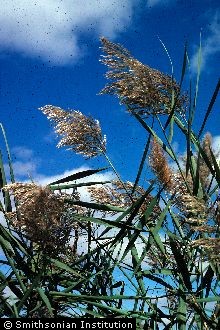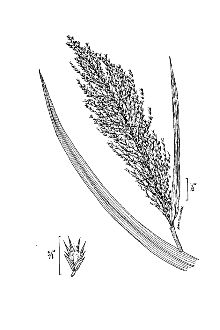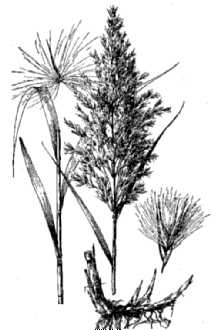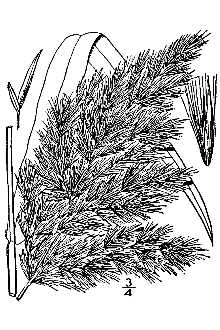Phragmites communis Trin. ssp. berlandieri (Fourn.) Á. Löve & D. Löve
Scientific Name: Phragmites communis Trin. ssp. berlandieri (Fourn.) Á. Löve & D. Löve
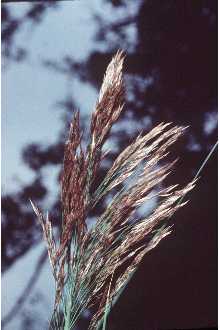
| General Information | |
|---|---|
| Usda Symbol | PHCOB |
| Group | Monocot |
| Life Cycle | Perennial |
| Growth Habits | GraminoidShrub, Subshrub, |
| Native Locations | PHCOB |
Plant Guide
Alternate Names
Alternate Common Names: Giant reed, Giant reedgrass, yellow cane, Phragmite, Carrizo, Danube grass, Roseau cane Alternate Scientific Names: Arundo australis Cavanilles; A. phragmites L. P. berlandieri Fourn; P. communis Trinius
Uses
Livestock Young plants of common reed are considered very palatable and readily grazed by sheep and cattle (Frankenberg, 1997). Mature plants are tough and unpalatable to livestock and wildlife (Letihead et al., 1971).
Wildlife
Common reed provides excellent cover for wildlife (Skinner, 2010) including hiding cover for deer, rabbits, pheasants and other animals. Common reed also provides nesting cover for wide variety of waterfowl and shoreline birds. Waterfowl eat the seed, and muskrats and nutrias eat the rhizomes and stems (Stubbendieck et al., 2003). Erosion control Due to its dense root matrix and coarse stems, common reed has been recommended for shoreline and earthen dam stabilization (USDA NRCS, 1999). It is used by mining operations for stabilizing ditch banks (Walker and Grimes, 1997). Common reed has also been used to trap silt and improve water quality (Frankenberg, 1997). Native grass species are recommended to prevent accidental spread of invasive type common reed (Saltonstall, 2010). Only native common reed should be used, and it should be used only where it can be properly managed.
Status
Common reed is considered an invasive or problematic weed in numerous states. It is a Class C noxious weed in Alabama. It is a banned invasive weed in Connecticut and prohibited in Massachusetts. Common reed is labeled a plant pest and an invasive aquatic plant in South Carolina. In Vermont it is designated as a Class B noxious weed. The state of Washington separated out the non-native genotype from native forms. The invasive form is a class C noxious weed (USDA-NRCS, 2012). Please consult the PLANTS Web site and your State Department of Natural Resources for this plant’s current status (e.g., threatened or endangered species, state noxious status, and wetland indicator values).
Weediness
A non-native form of this plant may become weedy or invasive in some regions or habitats and may displace desirable vegetation if not properly managed. Please consult with your local NRCS Field Office, Cooperative Extension Service office, state natural resource, or state agriculture department regarding its status and use. Weed information is also available from the PLANTS Web site at http://plants.usda.gov/. Please consult the Related Web
Description
General: Grass family (Poaceae). Common reed is a large rhizomatous/stoloniferous cool season grass obtaining heights of up to 4 m (13 ft) with stems averaging 0.5 to 1.5 cm (0.2 to 0.6 in) in diameter. The leaf sheath is open. The ligule is a ring of hairs averaging 1 to 2 mm (0.4 to 0.8 in) in length. Auricles are absent. The leaves are cauline, rolled or flat, and1 to 5 cm (2 in) wide and 10 to 60 cm (4 to 24 in) long (Hitchcock and Cronquist, 1973). The inflorescence is a loose to tight purple tinged 15 to 40 cm (6 to 16 in) long panicle. Spikelets are 12 to 15 mm (0.5 to 0.6 in) long and several-flowered. The rachilla (stem between the florets) is covered with long silky hairs. Glumes are unequal, 3- to 5- nerved and shorter than the florets (Barkworth et al., 2007; Skinner, 2010). Common reed produces male, female and perfect flowers. Common reed has an extensive system of scaly rhizomes and stolons which allow the plants to spread into dense monotypic stands. Stolons have been measured up to 18 m (60 ft) long (Welsh et al., 2003). The rhizomes produce a dense mat that ranges from 10 cm (4 in) to 2.5 m (8 ft) below the soil surface (Gucker, 2008). Rhizome depth is dependent on site conditions. There are three taxa or lineages of common reed found in the United States. The broadly distributed native (P. australis ssp. americanus) covers most of the United States and portions of southern Canada. The Gulf Coast type (ssp berlandieri) occurs in southern U.S. and Mexico. The nativity of this subspecies is uncertain. It may be a relatively recent migrant from Mesoamerica (Barkworth et al., 2007). The third type is native to Eurasia and has become invasive in most of the U.S. This taxon has not been officially named to subspecies as its relationships are unclear (Barkworth et al., 2007). It will hereafter be referred to as “invasive type.” Swearingen and Saltonstall (2010) provide images for distinguishing native and exotic forms. The following key from Saltonstall and Hauber (2007) will aid in separation of the three taxa. 1. Ligules 1.0 to 1.7 mm long; lower glumes 3.0 to 6.5 mm long; upper glumes 5.5 to 11.0 mm long; lemmas 8.0 to 13.5 mm long; leaf sheaths falling off with age; culms exposed in the winter, smooth and shiny; rarely occurs in a monoculture ……………..P. australis ssp. americanus (native lineage) 1. Ligules 0.4 to 0.9 mm long; lower glumes 2.5 to 5.0 mm long; upper glumes 4.5 to 7.5 mm long; lemmas 7.5 to 12.0 mm long; leaf sheaths not falling off with age; culms not exposed in the winter, smooth and shiny or ridged and not shiny; usually occurring as a monoculture……………………..……………………….2 2. Culms smooth and shiny; southern CA, AZ, NM, TX to FL ……..….P. australis ssp. berlandieri (Gulf Coast lineage) 2. Culms ridged and not shiny; southern Canada from British Columbia to Quebec south throughout the United States……………………P. australis (introduced lineage) Distribution: Common reed has been described as the most broadly distributed flowering plant in the world (Good, 1974). It is found on every continent except Antarctica (Gucker, 2008). Subspecies americanus is native to North America occurring in much of the US with the exception of the southeastern states. A second subspecies berlandieri is found along the southern edge of the United States from California to Florida. The non-native form was introduced into North America in the early 19th century (Saltonstall, 2002). It established first along the Atlantic coast and moved westward with the westward human expansion, likely spreading with aid of roadway and railroad development in late 19th and early 20th centuries (Saltonstall, 2002). Common reed (in the broadest sense) is currently found in all states but Alaska (USDA NRCS, 2012). Refer to Saltonstall et al. (2004) for distribution maps of the three lineages. For current distribution, please consult the Plant Profile page for this species on the PLANTS Web site. Habitat: Common reed occupies a variety of habitats throughout its range including tidal and non-tidal wetlands, marshes, springs, seeps, riparian and lacustrine areas from sea level to 7,000 ft (Hickman, 1993; Welsh et.al., 2003). Common reed often occupies disturbed sites forming monotypic stands, although the native subspecies are less likely to form dense stands than the invasive type. It is a dominant species in several vegetation types in the US and Canada. Because of its vast distribution, common reed grows in association with a wide variety of species associated with wetland and riparian plant communities.
Ethnobotany
Common reed was used extensively by Native Americans. The plants were used medicinally to treat diarrhea, and made into a poultice to treat boils (University of Michigan, 2012). Several tribes used common reed for building and weaving material from which they made mats, baskets, arrow shafts, flutes and rafts (University of Michigan, 2012). The seed was eaten as food, and the sugary sap from common reed was heated into a ball and dried to be eaten like candy (University of Michigan, 2012).
Adaptation
Common reed is adapted to a wide range of soil conditions from fine to coarse soil types, It is adapted to anaerobic conditions and soils with a pH range of 3,7 to 8,7 (Chabreck, 1972; USDA NRCS, 2012), Common reed is found in highly saline areas including salty tidal marshes and inland saline playas, The invasive type is more tolerant to salinity than the native lineages, Use soil moisture sensors to measure the soil moisture of Phragmites communis Trin. ssp. berlandieri (Fourn.) Á. Löve & D. Löve., Common reed is also adapted to frequent, prolonged flooding; however plant mortality has been reported after 3 or more years with more than 1 m (3 ft) of water (Shay and Shay, 1986),
Establishment
Common reed is established using stem cuttings or rhizomes (Frankenberg, 1997). Rhizomes should be planted into weed free soil that has been tilled to a depth of 10 to 15 cm (4 to 6 in). Recommendations for rhizome spacing vary. Rhizome sections 30 to 46 cm (12 to 18 in) long should be planted 10 to 15 cm (4 to 6 in) deep at a rate of 1 rhizome per foot of row. For shoreline erosion control plantings, a minimum of three rows are recommended at 40 inch row spacing parallel to the shoreline (Texas Agricultural Experiment Station, 1979). Erosion control plantings in northeast Texas reported >50% survival using 30 x 60 cm (12 x 24 in) spacing (Walker and Grimes 1997). The source area for rhizome collection should share similar characteristics to the planting site. Common reed clones from fresh water sites should not be used in saline situations (Frankenberg, 1997).
Management
For erosion control plantings it is recommended that livestock be excluded from planting sites during establishment (Texas Agricultural Experiment Station, 1979).
Pests and Potential Problems
There are no known pests associated with common reed. For information on potential problems, refer to “Environmental Concerns.”
Environmental Concerns
Concerns
Concerns
Native forms of common reed can form dense stands in suitable habitat, but they do not have the weedy tendencies of the non-native invasive type. The invasive type poses a threat to native wildlife and vegetation. It will crowd out native plants, alter wetland hydrology and increase fire potential (Keller, 2000; Saltonstall, 2010). It will form dense monocultures spreading by seed into open areas and then spreading rapidly vegetatively. It will spread by rhizome and stem fragments carried on water or via machinery (DiTomaso and Healy, 2003)
Control
Glyphosate treatments are the best option to reduce or control populations of common reed. Young populations with a less-developed rhizome network are more easily controlled than mature stands. Apply herbicides in late summer/early fall after flowering as foliar spray or on cut stumps. Repeat treatments for several years may be necessary to completely kill rhizomes (Saltonstall, 2010). Other control methods for common reed include deep “root burns”. Under typical conditions, common reed will be top killed by fire but the rhizomes will persist. Root burns require substantial litter accumulation and a completely dry rooting area for successful control. Repeated mechanical treatments can decrease growth but not cause plant mortality. Burning followed by flooding can cause mortality by eliminating oxygen transport from above ground leaves and stems to below surface tissues. It is recommended to use fire in conjunction with physical, mechanical and chemical control. Please contact your local agricultural extension specialist or county weed specialist to learn what works best in your area and how to use it safely. Always read label and safety instructions for each control method. Trade names and control measures appear in this document only to provide specific information. USDA NRCS does not guarantee or warranty the products and control methods named, and other products may be equally effective.
Seed and Plant Production
Plant Production
Plant Production
Seed production in common reed is variable. DiTomaso and Healy (2003) indicate that viable seeds have not been observed in North American populations. However, seedling emergence has been recorded in seed bank studies in Utah, Washington and elsewhere (Comes et al., 1978; Smith and Kadlec, 1983). Seed is dispersed by wind and water; however germination from seed is rare and dependent on site conditions. Germination requirements include full light, warm temperatures and moist but not flooded conditions (Gucker, 2003). Rhizome fragments are the primary means of spread of common reed. Rhizomes can be broken apart by environmental conditions including wave and wind action, or by mechanical disturbance. Non-native rhizome sprouts survived significantly better under higher levels of salinity than native genotypes (Vasquez et al., 2005). Commercial availability of common reed appears to be limited to rhizomes. Production fields should be planted in rows on sandy soils. Rhizomes can be harvested after a single growing season, but two years of growth are recommended. The USDA-NRCS James E. “Bud” Plant Materials Center in Knox City, Texas reported production yields of 75,000 to 100,000 rhizomes per acre per year (Texas Agricultural Experiment Station, 1979). Cultivars, Improved, and Selected Materials (and area of origin) ‘Shoreline’ common reed was selected at the James E. “Bud” Smith Plant Materials Center in Knox City TX with the intended use of shoreline stabilization and erosion control. It was released in 1978 for its superior wave action control and salinity tolerance. Shoreline was originally collected from a railroad right-of-way at Lawrence, Texas in 1970. Rhizomatous breeder stock is available from the PMC (Alderson and Sharp, 1994). ‘Southwind’ common reed was released in 1988 by the NRCS Manhattan, Kansas Plant Materials Center and the Kansas State University Agricultural Experiment Station. It is recommended for streambank and shoreline stabilization, rehabilitation of polluted waters, filter strips and constructed wetlands for sewage and sludge treatment. It is recommended for use in eastern Nebraska, Kansas and Oklahoma.
References
Alderson, J.A., and W.C. Sharp. 1994. Grass Varieties in the United States. USDA SCS Ag. Handbook No. 170. Washington DC. 296p. Barkworth, M.E., Anderton, L.K., Capels, K.M., Long, S., and M.B. Piep. 2007. Manual of Grasses for North America. Intermountain Herbarium and Utah State University Press. Utah State University. Logan, UT.625p. Chabreck, R.H. 1972. Vegetation, water and soil characteristics of the Louisiana coastal region. Bulletin 664. Louisiana State University, Louisiana Agricultural Experiment Station. Baton Rouge, LA. 72p. Comes, R.D, Bruns, V.F, and A.D. Kelley. 1978. Longevity of certain weed and crop seeds in fresh water. Weed Science. 26(4): 336-344. DiTomaso, J.M. and E.A. Healy. 2003 Aquatic and Riparian Weeds of the West. University of California Agriculture and Natural Resources. Publication No. 3421. 442p. Frankenber, J. 1997. Guidelines for growing Phragmites for erosion control. Cooperative Research Centre for Freshwater Ecology. Murray-Darling Freshwater Research Centre. Albury, NSW, Australia. 21p. Good, R. 1974. Geography of Flowering Plants. Longman Group, United Kingdom. 574p. Gucker, D.L. 2008. Phragmites australis. In: fire Effects Information System, [Online]. USDA, forest Service, Rocky Mountain Research Station. Available: http://www.fs.fed.us/database/feis/ [July 27, 2012]. Hickman, J.C. ed. 1993. The Jepson Manual: Higher Plants of California. University of California Press. Berkeley, CA. 1400p. Hitchcock, C.L. and A. Cronquist. 1973. Flora of the Pacific Northwest. University of Washington Press. Seattle, WA. 730p. Keller, B.E.M. 2000. Plant diversity in Lythrum, Phragmites, and Typha marshes, Massachusetts, USA. Wetlands Ecology and Management. 8: 391-401. Leithead, H.L., Yarlett, L.L., and T.N. Shiflet. 1971. 100 native forage grasses in 11 southern states. Agricultural Handbook No. 389. USDA-Forest Service, Washington, DC. 216p. Saltonstall, K. 2002. Cryptic invasion by a non-native genotype of the common reed, Phragmites australis, into North America. Proceedings of the National Academy of Sciences. 99(4): 2445-2449. Saltonstall, K. 2010. Fact Sheet: Common Reed. Plant Conservation Alliance’s Alien Plant working Group. Available. http://www.nps.gov/plants/alien/ [July 28, 2012. Saltonstall, K. and K. Hauber. 2007. Notes on Phragmites australis (Poaceae: Arundinoideae) in North America. J. Bot. Res. Inst. Texas. 1(1): 385-388. Saltonstall, K., Peterson, P.M. and R.J. Soreng. 2004. Recognition of Phragmites australis subsp. americanus (Poaceae:arundinoideae) in North America: evidence from morphological and genetic analyses. SIDA 21(2): 683-692. Shay, J.M and C.T. Shay. 1986. Prairie marshes in western Canada, with specific reference to the ecology of five emergent macrophytes. Canadian Journal of Botany. 64: 443-454. Skinner, Q.D. 2010. A Field Guide to Wyoming Grasses. Education Resources Publishing. Cumming, GA. 596p. Smith, L.M, and J.A. Kadlec. 1983. Seed banks and their role during drawdown of a North American marsh. Journal of Applied Ecology. 20: 673-684. Stubbendieck, J., Coffin, M.J., and L.M. Landholt. 2003. Weeds of the Great Plains. Nebraska Department of Agriculture, Bureau of Plant Industry. 605p. Swearingen, J. and K. Saltonstall. 2010. Phragmites Field Guide: Distinguishing native and extotic forms of common reed (Phragmites australis) in the United States. Plant Conservation Alliance, Weeds Gone Wild. Available: http: www.nps.gov/plants/alien/pubs/index.htm Texas Agricultural Experiment Station. 1979. Shoreline Common Reed. Texas A&M University System. Brochure L-1776. University of Michigan. 2012. Native American Ethnobotany. http://herb.umd.umich.edu/ USDA NRCS. 1999. Streambank and shoreline protection conservation practice 580. Plant Materials Fact Sheet. Temple, TX. 2p. USDA NRCS. 2012. The PLANTS database. [Online]. Available. http://plants.usda.gov [27 July, 2012]. Vasquez, E.A., Glenn, E.P., Brown, J.J., Guntenspergen, G.R, and S.G. Nelson. 2005. Salt tolerance underlies the cryptic invasion of North American salt marshes by an introduced haplotype of the common reed Phragmites australis (Poaceae). Marine Ecology Progress Series. 298: 1-8. Walker, M.J. and C. Grimes. 1997. Ditch stabilization with shoreline common reed. National Meeting of the American Society for Surface Mining and Reclamation. Austin, TX. May 10-15. 1997. Welsh, S.L., Atwood, N.D., Goodrich, S. and L.C. Higgins. 2003. A Utah Flora. Brigham Young University. Provo, UT. 912p. Prepared By: Derek Tilley, USDA NRCS Plant Materials Center, Aberdeen, ID Loren St. John, USDA NRCS Plant Materials Center, Aberdeen, ID Citation Tilley, D.J., and L. St. John. 2012. Plant Guide for common reed (Phragmites australis). USDA-Natural Resources Conservation Service, Aberdeen, ID Plant Materials Center. 83210-0296. Published August, 2012 Edited: 8Aug2012djt; 8Aug2012ls For more information about this and other plants, please contact your local NRCS field office or
Fact Sheet
Alternate Names
giant reed, giant reedgrass, Roseau, roseau cane, yellow cane, cane, Phragmites communis
Uses
Although coarse, common reed is readily eaten by cattle and horses, It provides high quality warm-season forage but becomes tough and unpalatable after maturity, Animals grazing this grass during winter should be fed a protein concentrate, This plant has been used in the Southwest for lattices in constructing adobe houses, Indians have used the stems for arrows, weaving mats, and carrying nets, Use soil moisture sensors to measure the soil moisture of Phragmites communis Trin. ssp. berlandieri (Fourn.) Á. Löve & D. Löve.,
Status
Considered a noxious weed in several states. Please consult the PLANTS Web site and your State Department of Natural Resources for this plant’s current status, such as, state noxious status and wetland indicator values.
Description
Grass Family (Poaceae). Common reed is a warm-season, rhizomatous, stoloniferous perennial, native to the U.S. The height ranges from 6 to 12 feet. The leaf blade is flat; smooth; 1/2 to 2 inches wide; and 6 to 18 inches long. The seedhead is an open panicle with a purplish or tawny and flaglike appearance after seed shatter. Common reed is readily identified by its height. It is the tallest grass in southern marshes and swamps.
Management
This grass cannot withstand prolonged heavy grazing. Its upright growth makes it easy for livestock to remove all the leaves. For maximum production, no more than 50 percent of current year's growth by weight should be grazed off during growing season. Common reed tolerates burning if water is above soil surface. Burning is not essential for management. Water control that lowers the water level, but does not drain the area, increases production. Grazing deferments of 60 to 90 days every 2 to 3 years during the growing season improve plant vigor.
Establishment
Growth starts in February in some locations. Foliage stays green until frost. New shoots grow from buds at nodes of old, stems, stolons, and rhizomes. It grows in marshes and swamps, on banks of streams and lakes, and around springs. It grows best in firm mineral clays and tolerates moderate salinity. It does best if water level fluctuates from 6 inches below soil surface to 6 inches above. Common reed is often codominant with big cordgrass (Spartina cynosuroides) on the gulf coast marsh rangelands. Cultivars, Improved and Selected Materials (and area of origin) Please contact your local NRCS Field Office.
Plant Traits
Growth Requirements
| Temperature, Minimum (°F) | -38 |
|---|---|
| Adapted to Coarse Textured Soils | Yes |
| Adapted to Fine Textured Soils | Yes |
| Adapted to Medium Textured Soils | Yes |
| Anaerobic Tolerance | High |
| CaCO3 Tolerance | Medium |
| Cold Stratification Required | No |
| Drought Tolerance | Low |
| Fertility Requirement | Medium |
| Fire Tolerance | High |
| Frost Free Days, Minimum | 110 |
| Hedge Tolerance | Low |
| Moisture Use | Medium |
| pH, Maximum | 8.7 |
| pH, Minimum | 4.5 |
| Planting Density per Acre, Maxim | 4800 |
| Planting Density per Acre, Minim | 3450 |
| Precipitation, Maximum | 60 |
| Precipitation, Minimum | 12 |
| Root Depth, Minimum (inches) | 20 |
| Salinity Tolerance | High |
| Shade Tolerance | Intolerant |
Morphology/Physiology
| After Harvest Regrowth Rate | Moderate |
|---|---|
| Toxicity | None |
| Resprout Ability | No |
| Shape and Orientation | Erect |
| Active Growth Period | Spring |
| Bloat | None |
| C:N Ratio | High |
| Coppice Potential | No |
| Fall Conspicuous | No |
| Fire Resistant | No |
| Flower Color | White |
| Flower Conspicuous | No |
| Foliage Color | Green |
| Foliage Porosity Summer | Dense |
| Foliage Porosity Winter | Moderate |
| Fruit/Seed Color | White |
| Nitrogen Fixation | Low |
| Low Growing Grass | No |
| Lifespan | Long |
| Leaf Retention | No |
| Known Allelopath | No |
| Height, Mature (feet) | 13.0 |
| Growth Rate | Rapid |
| Growth Form | Rhizomatous |
| Fruit/Seed Conspicuous | Yes |
| Foliage Texture | Coarse |
Reproduction
| Vegetative Spread Rate | Rapid |
|---|---|
| Small Grain | No |
| Seedling Vigor | High |
| Seed Spread Rate | Slow |
| Fruit/Seed Period End | Fall |
| Propagated by Tubers | No |
| Propagated by Sprigs | Yes |
| Propagated by Sod | No |
| Propagated by Seed | No |
| Propagated by Cuttings | No |
| Propagated by Container | No |
| Propagated by Bulb | No |
| Propagated by Bare Root | No |
| Fruit/Seed Persistence | Yes |
| Fruit/Seed Period Begin | Summer |
| Fruit/Seed Abundance | Medium |
| Commercial Availability | Routinely Available |
| Bloom Period | Summer |
| Propagated by Corm | No |
Suitability/Use
| Veneer Product | No |
|---|---|
| Pulpwood Product | No |
| Protein Potential | Low |
| Post Product | No |
| Palatable Human | No |
| Palatable Graze Animal | Low |
| Palatable Browse Animal | Low |
| Nursery Stock Product | No |
| Naval Store Product | No |
| Lumber Product | No |
| Fodder Product | No |
| Christmas Tree Product | No |
| Berry/Nut/Seed Product | No |

